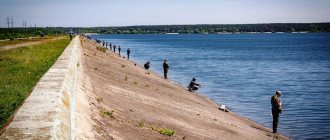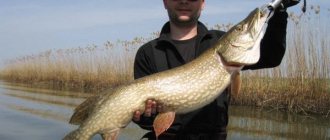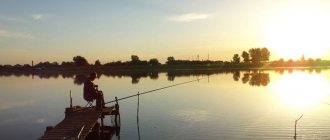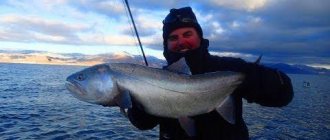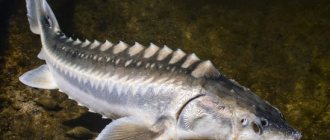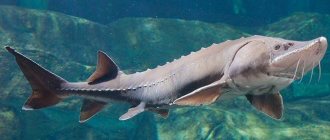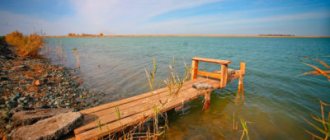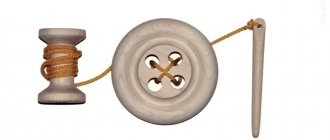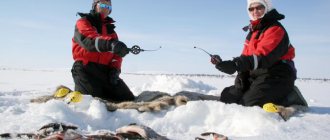Lake Senezhskoe is one of the most beautiful places in the Moscow region, simply a paradise for fishing and recreation. This is a reservoir that was formed during the construction of the Catherine Canal from 1826 to 1850, between the Istra and Sestra rivers.
Our article will tell you about Lake Senezh, the possibilities of paid and free fishing, what types of fish can be caught, which fish farms are located on Senezh, as well as reviews from anglers.
The story of “birth”
A nine-kilometer canal was erected, built of stone to last for centuries. Twelve locks were erected on the Istra River, and about twenty on the Sestra River. Bridges and dams were built over the locks. The dam that blocked the Sestra River inevitably increased the volume of water.
So, in the swampy source, on the site of the small lake Gushchino, a new reservoir was founded, which received its name, as everyone now knows - Lake Senezh:
- has a huge area - more than nine hundred hectares;
- the length of the coastal zone is about twenty kilometers;
- depth - up to four meters.
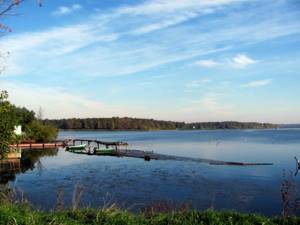
On the Sestra River, in the platinum area, there are deep-water places. The depth of the bottom of the Mazikha River reaches five meters. In this part, the reservoir is separated from the main reach by an underwater ridge. In other places the greatest depth of the lake is 3 meters. The level of the reservoir is approximately the same, along the so-called coastline.
This lake has a unique shape:
- 2 bays stretch along the lowlands of the Mazikha and Sestra rivers.
- From the south, two small streams flow in.
- The bottom is mostly muddy, only slightly sandy near the dam.
- The shores in the eastern and western directions are elevated, while in the south, on the contrary, they are low-lying and slightly swampy.
- The northern shore of the lake was formed by an artificial dam: one and a half kilometers long.
In the eastern and southern directions, in the old beds of the Sestra and Mazikha rivers, huge bays with a marshy bottom formed. In the place where the Sister flows into the lake, the Raspberry Islands are located, occupying more than two hectares of land.
Not far from them, within a half-kilometer radius, the entire bottom is covered with snags. Lake Senezh is replenished by the Mazikha and Sestra rivers, small springs and streams.
Climate and nature of the Moscow region
The climate of the Moscow region is moderate continental. In the eastern and southeastern regions, the climate is more continental. And it manifests itself in high summer and especially low winter air temperatures. Seasonality is well expressed: winter is cold, summer is hot.
Time of average daily air temperature below 0°C. As a rule, it lasts for 140 days. Starts in November and continues until March. The average annual temperature ranges from 3 to 6 °C.
The especially cold winter month is January, average t:
- western part −8 °C;
- eastern −12 °C.
Big frosts come with the onset of an Arctic cyclone (−25 °C and below). They usually last up to a month, but, as a rule, such periods can be shorter. In the winter season, especially in December and February, frequent thaws are common. They are mainly caused by Atlantic, sometimes Mediterranean cyclones.
They do not last long, up to four days; if we count November and March in general, then no more than 50 days. Snow appears in November, melts in April, sometimes a little earlier.
In the summer , the entry of arctic air always contributes to the establishment of warm, sunny weather. When the anticyclone begins to lag, it means that the heating of the surface will be more intense, as a result of which the air temperature will increase.
This is dangerous: the start of forest fires, severe drought. It is also not uncommon for so-called subtropical masses to arrive from the south.
The course of summer is fickle and changes frequently. That's why the weather varies:
- with increased so-called cyclonic activity, the climate becomes cool and humid;
- with constant anticyclones, the climate will be dry and hot.
The nature of the Moscow region is unique and inimitable. Most of the territory is covered by forest zone in the south:
- taiga zone;
- mixed stripes;
- coniferous forests.
Forests occupy more than 50% of the entire territory of the region. Most of the region is included in the so-called zone of coniferous, broad-leaved and mixed forests. The strip of broad-leaved forests includes the territories located south of the Oka River.
At the same time, the only exception is the southern part of the Serebryano-Prudsky district, which belongs to the so-called forest-steppe zone. Along the lower right bank of the Moscow River, a strip of coniferous and broad-leaved forests goes north, reaching the city itself. The main tree species: oak, linden, maple, hazel, ash, elm.
Solnechnogorsk, weather forecast and fish bite
| Weather forecast and fish bite | Fishing calendar, from 02/16/2021 to 02/19/2021 | |||||||||||
| VT | SR | Thu | PT | |||||||||
| Times of Day | Evening | Night | Morning | Day | Evening | Night | Morning | Day | Evening | Night | Morning | Day |
| Cloudiness, precipitation | Partly cloudy | light snow | Mainly cloudy | light snow | light snow | light snow | Mainly cloudy | Mainly cloudy | Partly cloudy | Partly cloudy | Partly cloudy | Partly cloudy |
| Temperature °C | -14 | -13 | -14 | -15 | -11 | -15 | -18 | -22 | -15 | -22 | -22 | -22 |
| Pressure, mm. | 765 | 762 | 761 | 760 | 761 | 762 | 764 | 766 | 768 | 770 | 770 | 768 |
| Direction, | Wind southwest | Wind southwest | South wind | Wind southeast | East wind | Wind northeast | Wind northeast | North wind | North wind | Wind northwest | West wind | West wind |
| wind speed | 5 m/s | 4 m/s | 3 m/s | 2 m/s | 2 m/s | 2 m/s | 3 m/s | 2 m/s | 3 m/s | 2 m/s | 3 m/s | 4 m/s |
| According to the forecast, they will bite on: bloodworms crucian carp | 50% | 0% | 55% | 40% | 30% | 0% | 40% | 40% | 35% | 0% | 60% | 60% |
| According to the forecast, they will bite on: bloodworms Carp | 25% | 0% | 20% | 5% | 5% | 0% | 5% | 5% | 10% | 0% | 25% | 25% |
| According to the forecast, the fish will bite on: live bait (jigs), winter spinners, balancers Pike | 50% | 25% | 75% | 60% | 50% | 10% | 60% | 60% | 35% | 10% | 60% | 60% |
| According to the forecast, they will bite on: bloodworms, winter spoons, balance beams Perch | 60% | 0% | 65% | 50% | 40% | 0% | 50% | 50% | 45% | 0% | 70% | 70% |
| Bait: maggot, bloodworm Roach | 50% | 0% | 75% | 50% | 40% | 0% | 60% | 50% | 35% | 0% | 70% | 60% |
The bite forecast will help you better choose a fishing day in January, February, March, April, May, June, July, August, September. October, November, December in Serpukhov. You may also be interested in the bite forecast for all fish in the Moscow region, or fishing in the Moscow region. Well, there is fishing in the neighboring reservoirs in the Serpukhov region.
Fishing on Lake Senezhskoye by fishing season
The lake is not protected from all winds, and therefore even a small one can raise a large wave. But it is precisely this circumstance that works to the benefit of fishermen.
Long-term observations show:
- When it blows from the north: the fish move towards the dam and spillway.
- The best bite happens when the wind is directed from the south.
- When a strong wind blowing from the western or northern side does not stop for more than four days, an active bite begins from the center of the lake to the Raspberry Islands.
In autumn , when there is no precipitation and the sun is shining, you can successfully hunt for pike. At this time, large specimens, more than ten kilograms, are especially active.
In winter , ruff, perch, and small pike perch readily bite. On the first ice, the hunt for pike begins and continues until it melts. It is better to fish on frosty days and when there is a sharp warming.
When spring comes, the fish begin to show activity: ruff and bream, along the entire territory of the Mazikha River.
Summer fishing is especially popular. Bream, for example, is especially well caught during the full moon. Successful fishing will be: cloudy days, with little rain, and calm weather. There are few hunters to fish from the shore using a float rod. Probably because fish can only be seen near the shore in early spring or at night. Fishermen mainly use boats; it is more expedient and efficient.
Features of roach fishing
The roach in the lake is heavy. Many fishermen come specifically for this fish, especially since you can use any gear to catch it.
In the spring, this fish comes out of the water column and does not react well to bait, so fishing should be organized by searching for the most successful area.
As the water warms up, the roach goes deeper, so in the summer it is better to feed it with boiled pearl barley, semolina, but with the obligatory smell of vanillin.
A good bite practically happens on Veretyevsky Beach or Timonovskaya Dam.
Fishing farm “Senezh”: conditions and cost
The Senezh fish farm was built and put into operation in 1964.
Occupies 200 hectares and has:
- two wintering ponds;
- two nurseries;
- one feeding.
In the near future, the fishery farm plans to build two more ponds and seriously engage in trout breeding.
The main feature of the fish farm is that all the fish is grown without the use of feed, so it has a natural taste.
If you get there by car
You need to drive along the Leningrad highway to the city of Solnechnogorsk and pass McDonald's. Next, we reach the second traffic light and turn right at a large intersection. Follow the sign with the name “Timonovo”.
Continue driving without turning along the main road for about 5 km. When you drive along the dam you will see:
- a wonderful lake will open on the right;
- on the left is the fish farm.
Turn left when you see the sign for the Senezh fish farm, then you have arrived correctly.
If you start getting there without a car: We take the train from the central Leningradsky station to Solnechnogorsk, get off at the station called “Podsolnechnaya”. You can get there by bus number 440, if you sit at the metro station called “Vodny Stadion”. Then in the city of Solnechnogorsk, at the bus station, take bus number 25 and get to the stop called “Rybkhoz”.
Paid services
- Pond number 1 and number from 1500 rubles, catch rate 6 kilograms.
- The feeding pond canal and the pond itself. You can fish from a boat or shore (a metal boat is included in this price) - 2 thousand rubles, the catch rate is 10 kg.
- From the shore and dam, without a boat - one and a half thousand rubles, the catch rate is 10 kg. Prices for carp, pike, perch, crucian carp: 250 rubles per kilogram.
Basic Rules
- One person is allowed to use 3 types of gear.
- Catch time: “daytime”: beginning from 6:00 to 18:00.
- “night”: starts from 18:00 to 6:00 am.
- Pond No. 1 No. 2 – 250 rubles per 1 kilogram;
Forbidden:
- release caught fish weighing more than 5 kg only after inspection by a fish farm employee;
- swim only in designated places;
- remove from the territory and eat freshly caught fish without weighing.
The territory here is well-equipped, the nature is picturesque, and the fish are actively biting, and for a reasonable fee. Inhabitants: carp, bream, eel, pike perch, pike, crucian carp, grass carp.
There are all conditions for relaxation: cozy gazebos, barbecue facilities, equipment rental, well-thought-out access to the place of future fishing. It is possible to buy fresh fish and smoke the caught ones.
Fishing at the Senezh fish farm
The Senezh fishery consists of three small ponds and one large reservoir, which was created in the mid-twentieth century. One of the small reservoirs is intended exclusively for spinning anglers and is inhabited by pike and perch. A day trip to this reservoir will cost the fisherman 1000 rubles. The predator is caught in this pond throughout the year, and the catch rate is not limited.
On the other two ponds you can perfectly catch small carp weighing up to 5 kg and silver crucian carp weighing up to 1 kg. Fishing can be done with both float and feeder gear. The shores of small reservoirs are well lit, so many fishermen come to this fish farm for night fishing. A license for fishing on these ponds will cost about 2,000 rubles for 8 hours of fishing, while the catch rate is limited to ten kilograms. If a fisherman catches more than the norm, he will have to pay extra for each extra kilogram.
The large reservoir is of interest to those who like to catch trophy carp. On the largest pond, fish weighing more than 10 kg are often found. In addition to carp, this reservoir is inhabited by:
To fish for predators on a large pond at the fish farm, you can rent a rowing boat, which will cost the fisherman 1,500 rubles per day. The cost of a daily fishing pass is 3,000 rubles.
Fishing on Senezh will be of interest to both summer fishing enthusiasts and winter anglers. Fishing in the reservoirs of the Senezh fish farm will bring pleasure not only to experienced fishermen, but also to novice fishermen.
How can I get to
It is more convenient to get to Lake Senezhskoye from Moscow by car, but you can also use public transport.
By car: we drive along the Leningradskoye Highway to Solnechnogorsk, 65 kilometers, then turn right and reach the village of Timonovo.
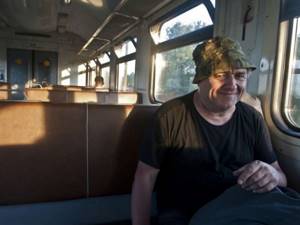
When you decide to use public transport: take the train from Leningradsky Station and get to Podsolnechnaya station. Then we transfer to bus number 25 or a minibus to the “House of Artist” stop, then walk.
Reviews from tourists
- Mikhail, 29 years old: “Previously, few people could afford paid fishing. But now it is quite accessible and civilized. Why go to some wild places and look for who knows what. I arrived, everything was arranged, it was beautiful. And, in general, it was not in vain that I went and caught carp, albeit small ones, and even a few pike. Inspired, I went home and now I know for sure that I will return again. Senezh is just super!”
- Vladimir, 46 years old: “After listening to stories about the lake and monster fish, I couldn’t stand it and quit work. I won’t tell you for a long time, I drilled fifty holes, but in the end I didn’t catch anything. Only four small roaches. There’s a lot of pleasure, but no sense.”
- Stepan, 56 years old: “I persuaded my godfather to go on a trip, although there were no special hopes for a big catch. We already came once, but it probably wasn’t our day. At the beginning, like last time, we came across small perches, we immediately released them and, probably, we were rewarded for this. Frequent bites began, and in general, we went home happy and with a good catch. And along the way they discussed the next trip!”
